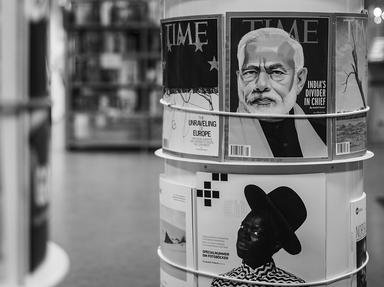Quiz Answer Key and Fun Facts
1. 1927-Although the Atlantic Ocean had been flown before, it was not until May 1927 that a young man flew it non-stop flight from Long Island, New York to Paris, France. It gained him immediate fame. Who was this daring pilot?
2. 1928-The "Time Magazine" Man of the Year was the man who established one of the so-called 'big three' auto manufacturing firms. What was his name?
3. 1929: The Reparations Conference of 1929-1930 was held to reappraise the previous reparations agreement following World War One. It was a querulous and heated debate. The Young Plan, put forth by Owen Young, chairman of the conference, was to ease economic pressure on Germany in light of the 1929 world-wide depression. It spurred "Time" to make Young 'Man of the Year'. What well-known company did Young set up?
4. 1930: For the first time "Time" selected a non-American for 'Man of the Year'. This well-educated man led a non-violent movement for peace and independence in a populous Asian nation. Who was the 1930 'Man of the Year'?
5. 1931: He was called the 'man with the white tie'. As a politician he was always controversial but was a force in French government for decades. As the world dealt with the depression, he was both a positive and negative force. He and President Herbert Hoover found little common ground. Who was this French leader?
6. 1932, 1934, and 1941: Three times this leader was named "Time Man of the Year". He was elected when the country was in the deepest aspect of the depression. He brought hope in terms of innovative programs to address the current issues as well as policies to provide prophylaxis for the future. He also had to prepare the nation for impending conflicts in Europe and the Pacific. Who was he?
7. 1933: U.S. President Franklin D. Roosevelt surrounded himself with with what the media called the 'Brain Trust'. As head of the National Recovery Act, Roosevelt appointed an army general with skills in leadership and organization. He also had a reputation as a writer and essayist. His role in Roosevelt's "New Deal" was instrumental. Who was the 1933 'Man of the Year'?
8. 1935: He was the second non-American to be selected as 'Man of the Year'. This African stood up against the oppression of colonialism on his continent. His appeal to the League of Nations revealed the weakness of that organization. Who was this Ethiopian leader?
9. 1936: This was the year that the gender barrier was broken by "Time" by naming a 'Woman of the Year'. This was a woman whose marriage disturbed the politics of a nation. Who was this 1936 femme fatale?
10. 1937: "Time" again broke precedent in 1937 and for the first time named a married couple for the recognition. Who were they?
Source: Author
Rehaberpro
This quiz was reviewed by FunTrivia editor
Snowman before going online.
Any errors found in FunTrivia content are routinely corrected through our feedback system.

